|
Throughout this site we use many technical terms, and given the breadth of readership our site enjoys, sometimes we are remiss and incorrectly assume everyone knows what we are referring to. For those that do not, here are some explanations of the technical terms use. |
 |
A style of car body design that has no B pillar between the doors and roof. |
 |
A graphical representation, compiled during the testing of an engine, of the disposal of the total heat provided by the fuel into (a) that converted into useful mechanical energy, (b) exhaust losses of heat, (c) coolant losses of heat, (d) radiation and friction losses. Percentages are given in each case for tests made under various loads and conditions. |
 |
Design artifices to ensure that a piston crown maintains a desired temperature to produce good thermal efficiency but does not reach a sufficiently excessive temperature which would promote pre-ignition and eventual failure of the piston material. At the same time it is desirable to keep the piston-skirt cool to prevent undue expansion. Thus a piston could be operating with a crown temperature of 250CC (483F) while the lower skirt is at 110C (230F). To this end horizontal slots may be cut in the piston walls to reduce the heat path or a heat dam may be employed.
|
 |
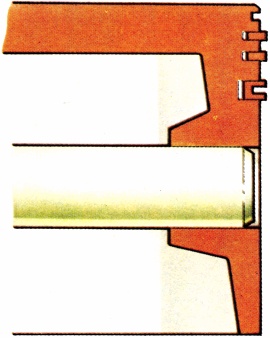
A circumferential cut made between the piston crown and the top ring groove to maintain a higher temperature in the crown.
|
 |
Energy involved in the change of temperature of a body or a change of state of a material (for example, water to steam). In the first case the total energy is the product of the mass of the body, the specific heat capacity of the material and the change in temperature. In the second case, no change of temperature occurs and the heat required or emitted is the product of the mass of the material and the appropriate latent heat value.
|
 |
Any engine which burns fuel to generate heat and through some medium (water for a steam engine, gases for an internal-combustion engine) converts heat energy into mechanical energy.
|
 |
Heat which is applied or cooled during a change of state with no temperature changes. Thus water at 100C (212F), requires considerable heat to convert to steam at 100C, (212F), known as the latent heat of steam or vaporization.
|
 |
The theoretical mechanical energy equivalent to unit quantity of heat energy, also known as Joules Equivalent. Expressed in units one BTU is equivalent, theoretically, to 107.2 kg/m (7781b/ft) or one CHU is equivalent to 193.5 kg/m (14001b/ft).
|
 |
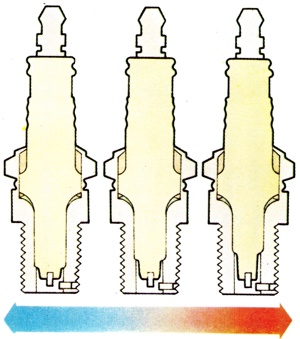
A spark plug is designed to operate at a temperature high enough to prevent the formation of carbon deposits but not high enough to cause pre-ignition, that is, the hot end igniting the fuel mixture before the timed spark can. The requirement for different designs of engine varies and plug manufacturers provide a range of plugs for any size and reach, having suitable heat characteristics for any application. By design difference, chiefly in the length of the path for heat conduction from the central electrode to the body of the plug, spark plugs vary in degree from "hot" to "cold".
|
 |
There are three ways in which heat is transferred from one body to another or from one part of a body to another part. They are: (a) Conduction: Heat travels through the material, from a hot to a cold region, similar to the flow of electricity. Thus heat from an exhaust valve is conducted through the stem and the guide, and from the seating to the cylinder block, and hence to the coolant, (b) Convection: Applicable only to liquids and gases, heated portions expand, becoming less dense and so rising to be replaced by cooler portions. Thermo-siphon cooling depends on such thermal currents, (c) Radiation: Heat travels across a space or void in the form of rays; thus on some cars a polished metal deflector is fitted between the exhaust manifold and the carburettor(s) to prevent heat radiated by the former causing vaporization of the fuel.
|
 |
The attainment of required qualities of toughness and hardness, by appropriate techniques of heating and cooling, including in the case of carbon and alloy steels, annealing, hardening, tempering and normalizing of the metals. |
 |
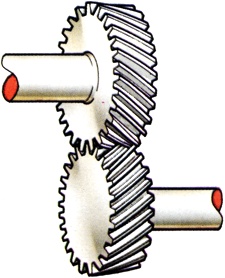
Cylindrical gears on which the teeth are cut on a helix, that is, at an angle to the axis and being curved also. This increases the contact area so reducing wear and eventual noise. Ideally the helix angle is chosen such that one end of a tooth comes into engagement before the opposite end of the previous tooth loses contact. The helix angle induces an axial thrust tending to throw the wheels out of mesh, so thrust bearings are necessary as double helical gears are used with opposing direction of axial thrust. The angularity prevents sliding into mesh, that is, such gearing is constant-mesh.
|
 |
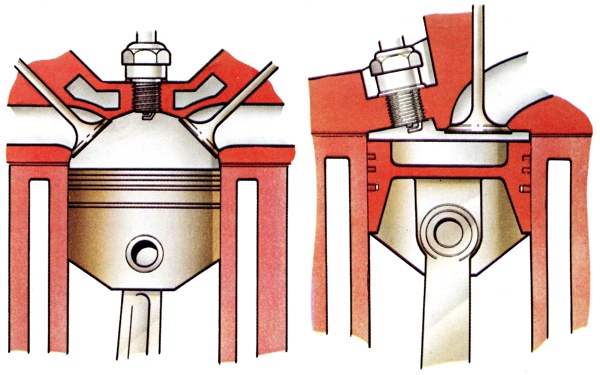
A design of cylinder head having a hemispherical combustion chamber, the piston crown being the flat side. Especially advantageous on longer stroke and thus smaller bore engines, the hemispherical roof permits larger valves and ports, as the valves can be set at angles, thus promoting greater volumetric efficiency (better breathing). At the same time better thermal efficiency is attained due to this shape producing less surface area for a given clearance volume - less heat is lost to the metal and to the coolant.
|
 |
An hydrocarbon fuel (C7 H)6) with poor anti-knock qualities, which, when mixed with another fuel octane (C8 H18), permits evaluation of the octane rating of any fuel on test, this value being the percentage of octane in an octane-heptane mixture which is found to give the same performance on test as the unknown fuel.
|
 |
The design of engine in which the combustion chamber is entirely located in the crown of the piston, under a flat cylinder head. On over-square engines where bore size permits adequate size of valves, this is a cheaper and simpler method of obtaining the high thermal efficiency of the hemispherical head.
|
 |
On a car this usually refers to HT leads connecting the coil to the distributor cap and the segments in the cap to the spark plugs. The HT circuit includes the secondary winding of the coil and subsequent leads to the spark plugs, the distributor cap and the rotor. (HT also stands for High Tensile, where bolts, nuts and screws are made of medium or high-carbon steel).
|
 |
A protective covering. On British and European open cars the hood is the roof of the passenger compartment, folding down to allow "open air" driving. American use of the term is for the covering of the engine compartment, which, in Australia, is known as the bonnet.
|
 |
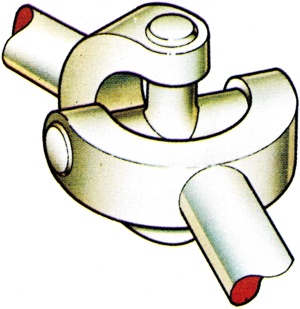
The common design of the three-part universal-joint where the fork end of one shaft is connected to that of the other by a four-legged spider. Such joints do not transmit torque at a uniform speed when operated with larger angles between the axes of the shafts but are acceptable for smaller angles. Sec also Constant-velocity joints.
|
 |
States that deflection of a spring (or the distortion of a wire up to the elastic limit) is directly proportional to the force producing it. Thus a spring is rated as the force required to produce a deflection of one inch (or centimetre). Whereas helical springs and leaf springs accord to this rule, diaphragm springs do not, which provides one advantage for the diaphragm spring clutch.
|
 |
A design of multi-cylinder engine where the cylinders are opposed to each other, in equal numbers, at an angle of 180. A horizontally-opposed, four-cylinder engine, such as that of the Citroen GS, may be known as a "Flat-Four". Such engines save height and provide a smooth torque but unless fitted with two or more carburettors involve complicated and lengthy manifolding.
|
 |
A British unit of power, used to define the rate at which work is done. Has been replaced by the kilowatt, and an approximate conversion is 100hp = 75kW. Devised in the early days of steam engines it allowed a reasonable comparison for the layman with the rate of working for a good horse and was the result of an experiment by James Watt. One horsepower is the power needed to move 33,0001b one foot in one minute and equals 0.746 kilowatts. Brake horsepower (bhp) is calculated from the torque measured by brake test at the output shaft. Indicated horsepower (ihc), calculated from the mean effect pressure acting on the piston and taking into account the cross-sectional area of the bore, the length of stroke and the number of power strokes in a minute, is thus the work done on all pistons of an engine in one minute. |
 |
A spark plug having a high operating temperature and thus able to avoid fouling by oil and carbon in engines prone to fouling cooler plugs. See Heat range (of spark plugs).
|
 |
To assist in vaporization of the fuel in the inlet manifold and to produce an homogeneous and finely atomized mixture to promote efficient combustion, exhaust gas may be by-passed to impinge on the inlet manifold, to produce a hot spot in the latter in each case. In some designs, a shutter in the exhaust is automatically operated by a bimetallic thermostat to divert a portion of the exhaust gas around this hot spot. Excessive heating of the inlet manifold is counterproductive as the density of the gas decreases and volumetric efficiency is impaired thus leading to poor engine performance.
|
 |
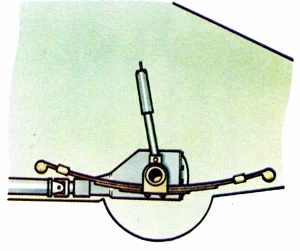
The most common type of rear suspension geometry with a live axle, the torque reaction from the driving wheels accelerating or braking is withstood by semi-elliptical or "leaf" springs or by struts where coil springs are used, so that only the road springs or struts resist the tendency of the axle casing to wind-up under heavy acceleration. On earlier quality cars the alternative was torque tube drive.
|
 |
A cavity or container designed to receive, support and locate a detachable item or assembly. Thus, for example, differential housing, clutch housing (or bell-housing) and thermostat housing.
|
 |
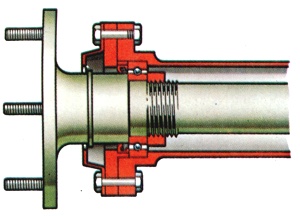
A simple design in which the hub is fixed to the half-shaft and a single bearing supports the hub inside the end of the hollow axle casing. Thus the weight of the car is taken on the end of the shaft which also resists all lateral loads and movements.
|
 |
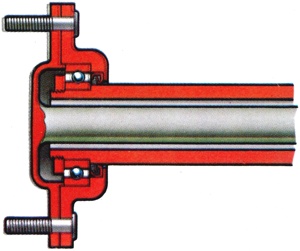
This contains one bearing carried on the outside of the hollow axle casing, so that the weight of the car is taken directly on the casing, as are side thrusts but lateral movements still rely partly on the half-shaft. Thus the half-shaft gives extra rigidity as well as transmitting torque.
|
 |
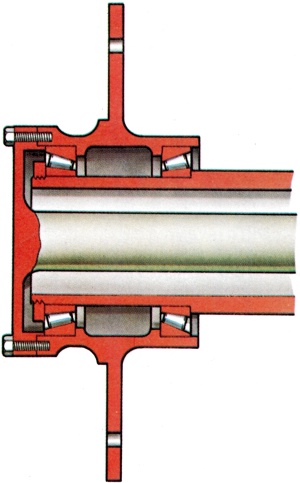
Used on older commercial vehicles, this design has two ball or taper roller bearings which support the hub on the outside of the axle casing, so that only torque is transmitted to the wheels by the driving shaft.
|
 |
Refers to an item or system operated by a liquid under pressure (see Hydraulic brakes).
|
 |
Friction brakes of either drum and shoe type or (invariably) disc types, which are actuated by an hydraulic system connecting the master cylinder operated by the pedal to the wheel cylinders acting on the shoes or disc pads of the brakes.
|
 |
A shock absorber whose damper action results from hydraulic flow through precisely machined orifices. |
 |
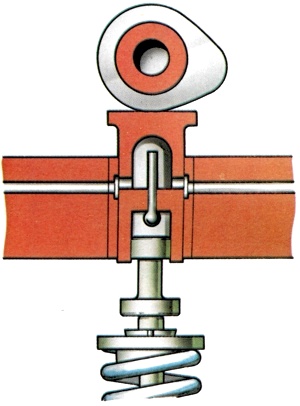
A design of tappet (or cam follower) in two telescopic parts providing an internal cavity into which engine oil under pressure is admitted through a non-return valve during running, thus eradicating all clearance between the camshaft, the tappet and the valve, so silencing the actuation and giving self-adjustment.
|
 |
A chemical compound consisting chiefly of two elements, hydrogen and carbon; thus fuels basically consisting of these elements are called hydrocarbon fuels and include such diverse materials as coal, petrol, wood and diesel fuel. During combustion, given the correct amount of oxygen, these elements produce water and carbon dioxide respectively.
|
 |
The study of fluid in motion.
|
 |
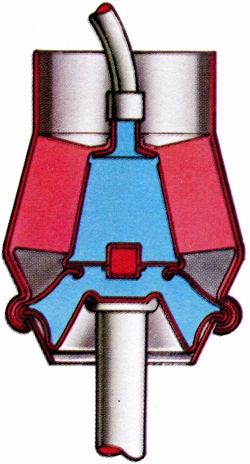
A design of car suspension using, in place of metal springs, rubber springs actuated by hydraulic pressure and having internal hydraulic damping and hydraulic inter-connection between wheel units to provide an overriding and stabilizing control, especially over fore and aft pitching.
|
 |
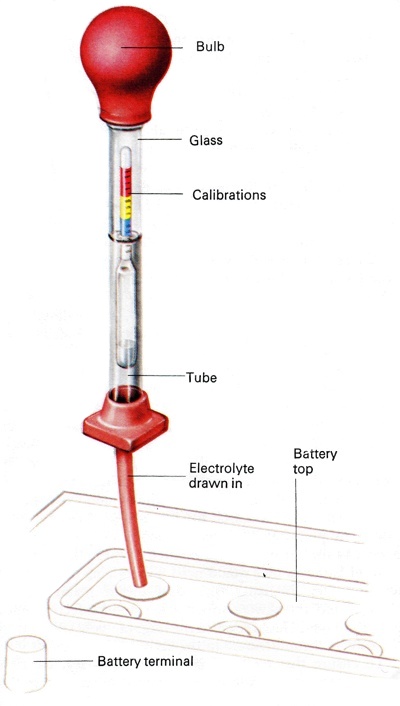
A device for measuring the specific gravity (relative density) of a liquid, such as the electrolyte of a lead-acid battery or the glycol mixture in the cooling system. It normally consists of a calibrated float contained in a glass cylinder into which a sample of the liquid is induced. The amount of water contained in the battery acid reflects the state of charge of the battery as a whole. The greater the water content, the lower the charge. The water content can be measured by sucking a small quantity of acid up from the battery and into a hydrometer. Inside the main tube is a small float, with a scale marked on one side. The acid level will be lower down the float if the water content is small, higher up the float if it is comparatively great. The hydrometer gives an extremely accurate but simple guide to the condition of your battery. A reading on the float of 1.280 shows a cell in good condition, if it falls as low as 1.1 50 the cell is flat. Be sure to check all the cells. If one gives a significantly different reading to the others it is almost certain that the battery has a major fault. |
 |
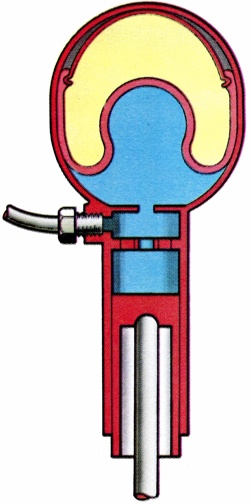
A suspension system in which each wheel assembly is supported on an arm operating a piston in a cylinder containing both air and liquid separated by a diaphragm, the oil content being supplied under control by an engine-driven pump and reservoir. Wheel units are interconnected and both suspension and damping are provided by the enforced movement of the liquid against the compressed air.
|
 |
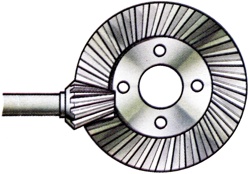
The usual design of final drive on Rear-Wheel-Drive cars consisting of a crown wheel and driving pinion, with the axis of the latter below that of the crown wheel that is, the axle centre line), lowering the prop-shaft, improving the floor design and lowering the centre of gravity of the axle. The gear teeth are curved and are longer and stronger than those of the previous spiral bevel wheels, giving longer life and less noise in use.
|
 |
Oil specially formulated with additives to withstand the extreme pressures generated between the teeth of hypoid gearing under heavy loading, which otherwise would break down the oil film. Extreme Pressure (EP) oils also resist high pressures, as in spiral bevel gearing I but are less able to withstand the I shearing action between hypoid gears.
|
|
|
Sell Your Car or Parts
Browse the Classifieds
It's Absolutely Free! - Find Out More
|



